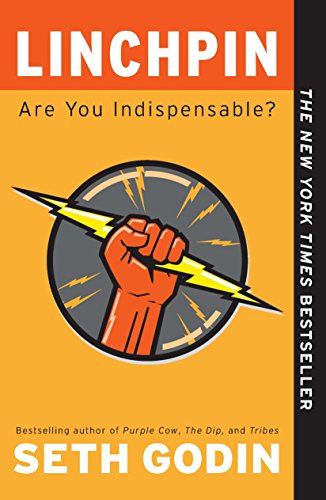Linchpin
Think you might want to read this book?
Seth Godin’s Linchpin proclaims that the industrial model of schooling and living as cogs in a machine is outdated, and in turn, explains how individuals can transform themselves into indispensable linchpins that create art, inspire human connections, and solve interesting problems. While the entire book does not specifically apply to teaching and learning, most of it does, and the remaining pieces are tiny motivators for game changers who are invested in the societies in which students will work. Godin chips away at traditional educational models that rely upon fear, compliance, and rote memorization; however, he also provides innovative alternatives centered around the belief in students, growth, leadership, and taking risks. One walks away from the book with a renewed zeal for both, growing personally as a linchpin, and inspiring others to do the same. Godin is at his best in Linchpin when he articulates how educators can imbue their students with a sense that they each possess a gift, or a set of gifts that they can use to create art and add value to the world - leading to both self-fulfillment and economic reward. As if all of that wasn’t enough to encourage a fruitful read, he hits a home run by challenging schools to evaluate how much their actual teaching and assessments match up to their mission statement and core values.
What Would Socrates Ask?
How can school leaders recruit, encourage, promote, and retain indispensable linchpin educators who solve problems, innovate, and practice the art of teaching and learning?
To what extent do our schools actually prepare students for the future?
How can schools train and empower young learners to be indispensable linchpins that bring humanity, connection, and art into their future roles in the ever-changing global economy?
Why is “being good with people” so diminished as a competency?
Research
“Author Richard Florida polled twenty thousand creative professionals and gave them a choice of thirty-eight factors that motivated them to do their best work. The top five are ranked here: (1) Challenge and responsibility (2) Flexibility (3) A stable work environment (4) Money (5) Professional Development - only one of these is a clearly extrinsic motivator (#4, money).”
Concepts
Schools exist to create compliant and efficient workers in an industrial economy. This is an outdated and insufficient purpose in our modern society.
A Linchpin… “is an individual who can walk into chaos and create order, someone who can invent, connect, create, and make things happen.” Chooses to lead and connect with passion and energy. Is flexible in the face of change and resilient in the face of confusion. Always leaning into the problem.
Our “lizard brain” (the amygdala) keeps us from doing anything too risky, too bold, too threatening, or too dangerous. This used to keep humans alive during hunter-gatherer times. Now it inhibits the very adaptability and calculated risk-taking we need to survive and thrive in today’s economy and society.
Schools need to stop teaching students to follow instructions and start teaching students to take intellectual risks, lead, make connections, solve interesting problems, and create art.
The new American Dream:
Be remarkable + Be generous + Create art + Make judgement calls + Connect people and ideas = We have no choice but to reward you
Too many schools are organized around fear. Teachers fear taking risks, such as getting low test scores, etc. Students fear failing grades, not fitting in, or not getting into the right college. Instead, schools should be organized around belief and growth. Teachers and students should be encouraged to do their best work, not just the most predictable work.
Being good at school is something that is largely irrelevant later on in life.
What separates a linchpin from an ordinary person is that an ordinary person reacts to fear by stopping that which is making them afraid. Then the fear leaves. “The linchpin feels the fear, acknowledges it, then proceeds.”
Quotes from the author
“Linchpins don’t work in a vacuum. Your personality and attitude are more important than the actual work product you create, because indispensable work is work that is connected to others.”
“Great teachers are precious. Lousy teachers cause damage that lasts forever. We need to reorganize our schools to free the great teachers from tests and reports and busy work, and to expel the lousy teachers.”
“Successful people are successful for one simple reason: they think about failure differently.”
Implement tomorrow?
Treat every interaction with students, parents, colleagues, and administrators as part of your art as a linchpin. Make eye contact, show sincere interest, make connections, encourage others, and treat others with the respect, dignity, and kindness they deserve.
Schedule one-on-one conferences with your students. Ask them what their interests are. Tell them when you see a gift that they possess, even if it is a tiny glimmer or flickering spark. Fuel this. Empower each of your students to be the linchpins that they will need to be in this ever-changing world.
As teachers, think deeply about what your unique gifts are, and find ways to use these gifts to solve the interesting problems facing your school. Becoming a linchpin yourself is one of the best ways to inspire others to be linchpins.
Organizations Working on Answers
Gateways to Further Learning
Referenced books for purchase
The applicability of this book to education is ….
Resources








